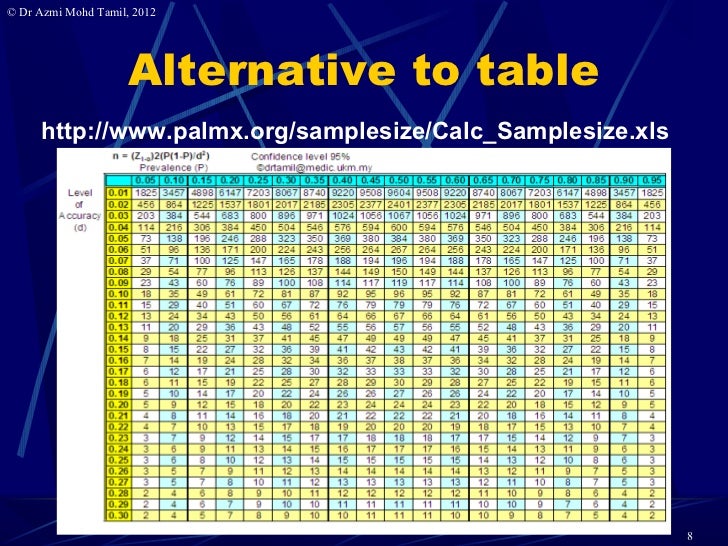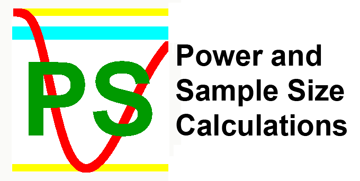Power And Sample Size Calculation A Review And Computer Program
Power and Sample Size Calculation Get PS. 'Power and Sample Size Calculations: A Review and Computer Program'. 'Power and Sample Size Calculations for. PS: Power and Sample Size. The program can generate graphs of sample size versus power. 'Power and Sample Size Calculations: A Review and Computer Program.
William D Dupont
Calculate samplesize for case-control studies. 1. © Dr Azmi Mohd Tamil, 2012 Calculate Your Own Sample Size – Part 5 Case-Control Study 1. © Dr Azmi Mohd Tamil, 2012 Case-Control In a case-control study, you identify the cases and controls.
Then you compare the rate of exposure/risk factor between the case and control group. For example you want to prove that cataract patients (cases) have a higher rate of diabetes mellitus (risk factor) compared to patients with normal vision (controls). From literature review, identify the rate of exposure among the cases (i.e. 50%) and among the controls (i.e.
Automotive diagnostic software for pc. How can the answer be improved?
Decide on the ratio; i.e. 1:1 2. © Dr Azmi Mohd Tamil, 2012 Example – DM higher risk of cataract From literature review, identify the rate of risk factor (DM) in cases and controls. Proportion of sample from controls (Normal) population = 50% Proportion of sample from cases (Cataract) population = 50% P1=true proportion of DM in controls (Normal) population = 8% P2=true proportion of DM in cases (Cataract) population =50% 3.
© Dr Azmi Mohd Tamil, 2012 From Literature Review: Cataract & Diabetes M. DM + (50%) Cataract Sample DM - (50%) ratio (1:1) DM + (8%) Normal vision DM - (92%) 4. © Dr Azmi Mohd Tamil, 2012 Calculate Manually Calculate using these formulas (Fleiss JL. 44-45) m=n1=size of sample from population 1 n2=size of sample from population 2 P1=proportion of exposure in population 1 P2=proportion of exposure in population 2 α= 'Significance” = 0.05 β=chance of not detecting a difference = 0.2 1-β = Power = 0.8 r = n2/n1 = ratio of cases to controls P = (P1+rP2)/(r+1) Q = 1-P. N1 = m n2 = rm From table A.2 in Fleiss; If 1- α is 0.95 then cα/2 is 1.960 If 1- β is 0.80 then c1-beta is -0.842 5. Calculate Manually© Dr Azmi Mohd Tamil, 2012 6.
Or Use StatCalc© Dr Azmi Mohd Tamil, 2012 So you need a sample size of only 22 cases and 22 controls. 7.

© Dr Azmi Mohd Tamil, 2012 Or use PS2 Sample size for case is 17 and for control 17. Total 34 StatCalc = 44 vs PS2 = 34 hmmm which would you prefer? 8.
© Dr Azmi Mohd Tamil, 2012 We are planning a study of independent cases and controls with 1 control(s) per case. Prior data indicate that the probability of exposure among controls is 0.08. If the true probability of exposure among cases is 0.5, we will need to study 17 case patients and 17 control patients to be able to reject the null hypothesis that the exposure rates for case and controls are equal with probability (power) 0.8. The Type I error probability associated with this test of this null hypothesis is 0.05. We will use an uncorrected chi-squared statistic to evaluate this null hypothesis. 9. © Dr Azmi Mohd Tamil, 2012 What If There Is No Prior Information?

Instead of saying 'Sample sizes are not provided because there is no prior information on which to base them“, do this instead; Find previously published information Conduct small pre-study If a very preliminary pilot study, sample size calculations not usually necessary 10. © Dr Azmi Mohd Tamil, 2012 Conclusion You can calculate your own sample size. Tools are available and most of them are free. Decide what is your study design and choose the appropriate method to calculate the sample size. If despite following ALL these notes fastidiously, your proposal is still rejected by the committee due to sample size, kindly SEE THEM, not us.
11. © Dr Azmi Mohd Tamil, 2012 References (incl.
D Walton Plummer
For StatCalc) Fleiss JL. Statistical methods for rates and proportions. New York: John Wiley and Sons, 1981. Clinical Trials in Cancer Research.
Environmental Health Perspectives Vol. Jones SR, Carley S & Harrison M. An introduction to power and sample size estimation. Emergency Medical Journal 2003;20;453-458. Survey sampling. John Wiley & Sons, N.Y., 1965. Krejcie, R.V.
& Morgan, D.W. Determining sample size for research activities. Educational & Psychological Measurement, 30, 607-610. Snedecor GW, Cochran WG. Statistical Methods. Ames: Iowa State Press.
12. © Dr Azmi Mohd Tamil, 2012 References (PS2) Dupont WD, Plummer WD, Jr: Power and Sample Size Calculations: A Review and Computer Program. Controlled Clinical Trials 11:116-128, 1990 Dupont WD, Plummer WD, Jr: Power and Sample Size Calculations for Studies Involving Linear Regression. Controlled Clinical Trials 19:589-601, 1998 Schoenfeld DA, Richter JR: Nomograms for calculating the number of patients needed for a clinical trial with survival as an endpoint. Biometrics 38:163-170, 1982 Pearson ES, Hartley HO: Biometrika Tables for Statisticians Vol. Cambridge: Cambridge University Press, 1970 Schlesselman JJ: Case-Control Studies: Design, Conduct, Analysis.
New York: Oxford University Press, 1982 Casagrande JT, Pike MC, Smith PG: An improved approximate formula for calculating sample sizes for comparing two binomial distributions. Biometrics 34:483-486, 1978 Dupont WD: Power calculations for matched case-control studies. Biometrics 44:1157-1168, 1988 Fleiss JL. Statistical methods for rates and proportions. New York: John Wiley and Sons, 1981. 13. © Dr Azmi Mohd Tamil, 2012 THANK YOU 14.